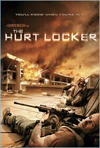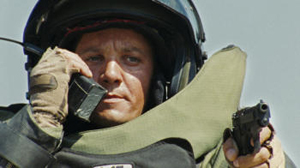The
Curious Case of Benjamin Button
Fantastic Mr. Fox
Gran Torino
Harry Potter and the Half Blood Prince
The Hurt Locker
The
Informant!
Julie and Julia
Milk
The Reader
Serious Man
Film Reviews from 2008
Film
Reviews from 2007
Film Reviews
from 2006
The Hurt Locker
In the opening sequence, a team on a routine mission loses their leader. Still grieving, the two surviving members, J. T. Sanborn and Owen Eldridge, meet their newest tean member, William James. Sanborn and Eldridge are shocked by James’ apparent reckless disregard for rules, protocol, and his own safety. This causes discord within the three-man unit who must rely on each other at every moment for their safety. Bigelow’s directorial style places the audience directly in the middle of the action. Some of the scenes involving James and his colleagues are so intense and suspenseful they are almost unbearable. Will the team dismantle the device, or will it explode in the hands of one of the team members? Bigelow has received great acclaim for her handling of these scenes. While I admired her skill, I can’t say I enjoyed watching these moments.
Sanborn is the consummate professional, who respects protocol, seeing that the mission is accomplished. Sanborn also cares deeply for his men, as well as the civilians in harm’s way. Eldridge is the character with whom many will identify: he does his job well, yet he is cautious and anxious on the mission. In contrast with James, Eldridge is all too happy when a device is disarmed and the job is done. Technically, The Hurt Locker is well done. Bigelow’s use of unknown actors in the leading roles helps to give the film an almost documentary feel. For a film like this, the violence is not overdone. Yet, as I said, I didn’t find the film particularly satisfying. The mayhem of the battle scenes would have been bearable, if I felt that I left with some deep understanding of the characters. With the exception of the fact that this one of the first dramatic films set against the Iraq war, The Hurt Locker does not offer any new insights. So, like Eldridge, I was glad when it was over and I could relax. Tom Condon, OP |



 This acclaimed new film from director Kathryn Bigelow and screenwriter Mark Boal takes us to Iraq in 2004. In this especially chaotic time in the war, The Hurt Locker focuses on the work of a three member EOD (Explosive Ordinance Disposal) team. The team searches out and dismantles bombs: everything from roadside bombs to one strapped to a man’s body. As you can imagine, this is a very intense film.
This acclaimed new film from director Kathryn Bigelow and screenwriter Mark Boal takes us to Iraq in 2004. In this especially chaotic time in the war, The Hurt Locker focuses on the work of a three member EOD (Explosive Ordinance Disposal) team. The team searches out and dismantles bombs: everything from roadside bombs to one strapped to a man’s body. As you can imagine, this is a very intense film.  As with all good war movies, Hurt Locker is as interested in the effects of the war on the men (and it’s almost all men in this case) as in the action scenes. James is the renegade, who seems to love his job and feeds on the adrenaline rush. He has a foot locker full of souvenirs from previous bombs he has worked on: a stash of bomb parts, wires, and ticking devices. James thrives on the chaos of war, and is like a fish out of water when he returns home.
As with all good war movies, Hurt Locker is as interested in the effects of the war on the men (and it’s almost all men in this case) as in the action scenes. James is the renegade, who seems to love his job and feeds on the adrenaline rush. He has a foot locker full of souvenirs from previous bombs he has worked on: a stash of bomb parts, wires, and ticking devices. James thrives on the chaos of war, and is like a fish out of water when he returns home.